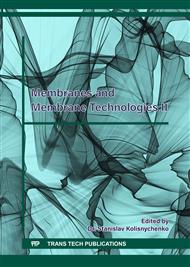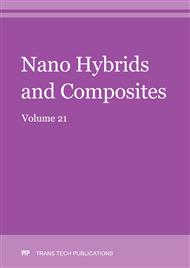[1]
Y. Yildirim, & R, Hughes. An experimental study of CO2 separation using a silica based composite membrane. Trans IChem, 81, B, pp.257-261, (2003).
DOI: 10.1205/095758203322299789
Google Scholar
[2]
http://www.telegraph.co.uk/earth/environment/climatechange/9717280/Doha–Latest-figuressh-ow-global-CO2emissions- are-rising.html [Accessed 10th February 2013].
Google Scholar
[3]
International Energy Outlook 2013, http://www.iea.org/Textbase/npsum/WEO 2013 SUM.pdf. [Accessed 10th February 2013].
Google Scholar
[4]
M. R. Othman, H. Mukhtar, & A. L. Ahmad. Gas permeation characteristics across nano-Porous inorganic membranes. IIUM Engineering Journal, vol. 5, pp.17-33, (2004).
DOI: 10.31436/iiumej.v5i2.379
Google Scholar
[5]
M. N. Kajama, N. C. Nwogu, & E. Gobina, Gas Permeation Study Using Porous Ceramic Membranes. Energy and Environment Research journal, vol. 4(3), pp.43-49, (2014).
DOI: 10.5539/eer.v4n3p43
Google Scholar
[6]
M. Mulder. Basic Principles of Membrane Technology, Second Edition, Centre of Membrane Science and Technology. Kluwer Academic Publishers, University of Twente, Enschede, The Netherlands, p.227, (1996).
Google Scholar
[7]
N. C. Nwogu, E. Gobina, & M. N. Kajama. Improved carbon dioxide capture using nanostructured ceramic membranes. Low Carbon Economy, vol. 4, pp.125-128, (2013).
DOI: 10.4236/lce.2013.43013
Google Scholar
[8]
Y. Yildirim, & R. Hughes. The Efficient Combustion of O-xylene in a knudsen Controlled Catalytic Membrane Reactor. Trans IChemE. 80(Part B): pp.159-164, (2002).
DOI: 10.1205/095758202317576265
Google Scholar
[9]
L. Zhang, I. Park, K. Shqau, W.S. Winston Ho, & H. Verweij. Supported inorganic membranes. Promises & Challenges, Vol. 61 pp.61-71, (2009).
DOI: 10.1007/s11837-009-0054-2
Google Scholar
[10]
A. L. Ahmad, & N. N. N. Mustafa. Sol-gel synthesized of nanocomposite palladium-alumina ceramic membrane for H2 permeability: preparation and characterization. International Journal of Hydrogen Energy, Vol. 32 pp.2010-2021, (2007).
DOI: 10.1016/j.ijhydene.2006.08.046
Google Scholar
[11]
http://ufdcimages.uflib.ufl.edu/AA/00/00/03/83/00141/AA00000383_00141_00062.pdf. [Acc-essed on 22/05/2016].
Google Scholar
[12]
Kim, Y., Kusakabe, K., Morooka, S., & Yang, S. Preparation of microporous silica membranes for gas separation. Korean Journal of Chemical Engineering, 18, pp.106-112, (2001).
DOI: 10.1007/bf02707206
Google Scholar
[13]
Ohwoka, A., Ogbuke, I., & Gobina, E. Performance of pure and mixed gas transport in reconfigured hybrid inorganic membranes part 2. Membrane Technology, pp.7-9, (2012).
DOI: 10.1016/s0958-2118(12)70126-x
Google Scholar
[14]
C. A. Scholes, S. E. Kentish, & G. W. Stevens. Carbon dioxide separation through polymeric membrane systems for flue gas applications. Recent Patents on Chemical Engineering, vol. 1, pp.52-66, (2008).
DOI: 10.2174/2211334710801010052
Google Scholar
[15]
Wall, Y., Ompe-Aime-Mudimu., Braun, G., & Brunner, G. Gas transport through ceramic membranes under super-critical conditions. Desalination, 250, pp.1056-1059, (2010).
DOI: 10.1016/j.desal.2009.09.107
Google Scholar
[16]
Jae-Hyun So, S.M. Yang & S. B. Park. Preparation of silica–alumina composite membranes for hydrogen separation by multi-step pore modifications. Journal of Membrane Science, Vol. 147, pp.147-158, (1998).
DOI: 10.1016/s0376-7388(98)00132-x
Google Scholar
[17]
F. I. Khan, & A. K. Ghoshal. Removal of volatile organic compounds from polluted air. Journal of Loss Prevention in the Process Industries, 13(6), pp.527-545, (2000).
DOI: 10.1016/s0950-4230(00)00007-3
Google Scholar
[18]
A. F. M. Leenaars & A. J. Burggraaf. The Preparation and Characterization of Alumina Membranes with Ultrafine Pores: Part 3. The permeability of pure liquids. Journal of Membrane Science, Vol. 24, pp.245-260, 1985a.
DOI: 10.1016/s0376-7388(00)82243-7
Google Scholar
[19]
Smart, S. Liu, S. Serra, J. M. Diniz da Costa, J. C. Iulianelli, A. & Basile A. Porous ceramic membranes for membrane reactors. (2013).
DOI: 10.1533/9780857097330.2.298
Google Scholar
[20]
G. Q. Lu, J. C. Diniz da Costa, M. Duke, S. Giessler, R. Socolow, R. H. Williams, & T. Kreutz. Inorganic membranes for hydrogen production and purification: A critical review and perspective. Journal of Colloid and Interface Science, vol. 314, pp.589-603, (2007).
DOI: 10.1016/j.jcis.2007.05.067
Google Scholar
[21]
J. D. Way, & D. L. Roberts. Hollow Fiber Inorganic Membranes for Gas Separations. Sep. Sci. Tech., 27(1), pp.29-41, (1992).
Google Scholar
[22]
E. Gobina, Apparatus and Methods for Separating Gases. United States Granted Patent No. US 7048778, May 23, (2006).
Google Scholar
[23]
P. Huang, N. Xu, J. Shi, & Y. S. Lin. Recovery of volatile organic compounds from air by ceramic membranes. Ind. Eng. Chem. Res., vol. 36, pp.3815-3820, (1997).
DOI: 10.1021/ie960760b
Google Scholar
[24]
A. Ohwoka, I. Ogbuke, & E. Gobina. Performance of pure and mixed gas transport in reconfigured hybrid inorganic membranes part 1. Membrane Technology, pp.7-12, (2012).
DOI: 10.1016/s0958-2118(12)70126-x
Google Scholar
[25]
B. A. McCool, N. Hill, J. DiCarlo, & W. J. DeSisto. Synthesis and characterization of mesoporous silica membranes via dip-coating and hydrothermal deposition techniques. Journal of Membrane Science, vol. 218, pp.55-67, (2003).
DOI: 10.1016/s0376-7388(03)00136-4
Google Scholar
[26]
M. Asaeda, & S. Yamasaki. Separation of Inorganic/Organic Gas Mixtures by Porous Silica Membranes. Sep. Purif. Tech., 25, pp.151-159, (2001).
DOI: 10.1016/s1383-5866(01)00099-5
Google Scholar



